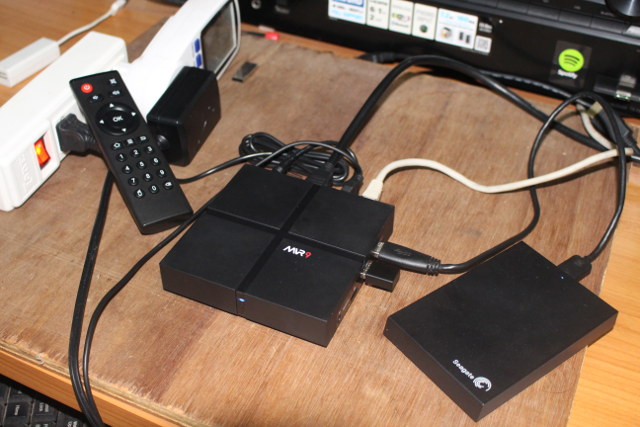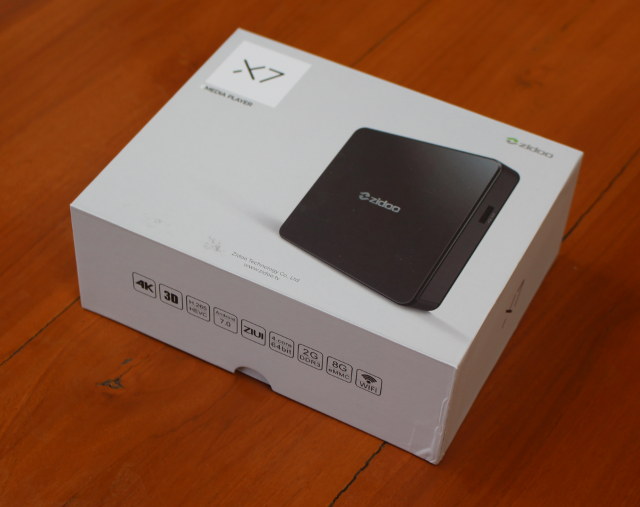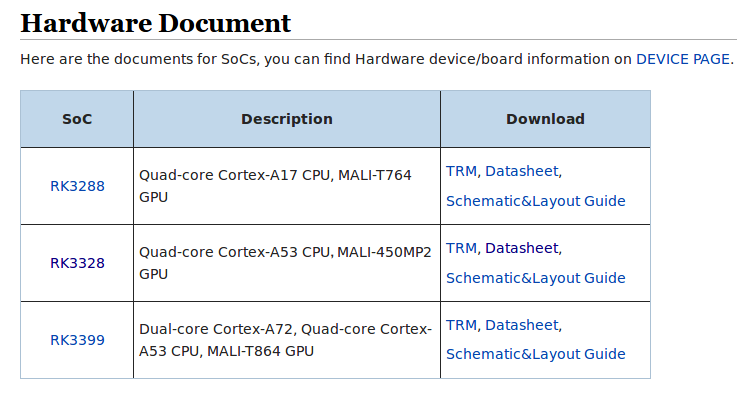Videostrong VS-RD-RK3399 development board is a full-featured development based on Rockchip RK3399 hexa-core processor with up to 4GB RAM, and 32GB eMMC flash, and plenty of I/Os. The company has sent me a sample, and after getting some trouble going through customs with questions like “what is a development board?” and “is it a board for TV boxes or computers?”, I finally got hold of the parcel. Today, I’ll check out the board and its accessories, show how to assemble it, and since the company shared more info about documentation and software, quickly go over what’s available. Videostrong VS-RD-RK3399 Development Kit Unboxing The board was in a bland carton box, which is fine since it’s not a consumer product, with a stick showing I got the 4GB LPDDR3 / 32GB eMMC flash version. There’s also a board using 2GB/16GB configuration. The package includes the board, bottom and top acrylic plates […]
Bqeel MVR9 (NT-N9) TV Box Review – Part 2: Android Nougat Firmware, RKMC, YouTube 4K, and More
Bqeel MVR9 is another TV box powered by Rockchip RK3328, but that model comes with Gigabit Ethernet and 2GB RAM contrary to the cheaper A95X R2 TV box I previously reviewed. If you want to check thsee some pictures read “Bqeel MVR9 TV Box Review – Part 1: Specifications, Unboxing and Teardown“, as in this second part I’ll focus on the firmware, and we’ll see if the claims of better 4K video playback thanks to DDR4, optimized RKMC with HD audio pass-through, YouTube 4K, and DRM support are true. First Boot, Setup, and First Impressions One good thing about Bqeel MVR9 is that it comes four 4 USB port, so I did not need to use a USB hub to connect my two RF dongles for MINIX NEO A2 Lite air mouse and Tronsmart Mars G01 gamepad, a Seagate USB 3.0 hard drive, and a USB keyboard I normally use […]
VideoStrong VS-RD-RK3399 is Another Development Board Based on Rockchip RK3399 Processor
VideoStrong is better known for their Android set-top boxes with digital TV tuners, but they are making other hardware too, and their latest design is a Rockchip RK3399 development board named VS-RD-RK3399. VideoStrong VS-RD-RK3399 board specifications: SoC – Rochchip RK3399 hexa-core big.LITTLE processor with two ARM Cortex A72 cores up to 2.0 GHz and four core Cortex A53 cores, ARM Mali-T860 MP4 GPU with OpenGL 1.1 to 3.1 support, OpenVG1.1, OpenCL and DX 11 support System Memory – Dual channel 2GB or 4GB DDR3 Storage – 16/32 GB eMMC 5.1 flash, micro SD card Video Output & Display Interfaces 1x HDMI 2.0 up to 4K @ 60 Hz 1x DisplayPort up to 4K @ 60 Hz 1x MIPI DSI dual channel interface up to 2560×1600 @ 60 Hz 1x eDP (embedded DisplayPort) 1.3 with 4-lanes @ 10.8 Gbps 1x I2C interface for touch panel Video Decode – 4K VP9 and […]
Zidoo X7 TV Box Review – Part 1: Unboxing & Teardown
Zidoo X7 is another Rockchip RK3328 based TV box that has the advantage of coming with 2GB RAM, 802.11ac WiFi and Bluetooth 4.1, as well as Zidoo firmware support, compared to its cheaper competitors such as A95X R2 TV box. The company sent me a review sample to check out it. As a side note, it was quite a challenge to get the box, as my country of residence enacted a new law requiring a “broadcasting license” to import TV boxes and HDMI dongles, even if you get just one unit, so the first attempt failed to got through customs, but eventually I managed to get the box through a local reseller. Back to the review… As usual I’ll write a first part showcasing the hardware design today, before testing the firmware, and publishing my results next month. Zidoo X7 Unboxing The package shows some of the key features of […]
ROCK64 Board Review – Part 2: Quick Start Guide with Ubuntu 16.04.3 MATE, Multimedia Features, Some Benchmarks
Pine64 ROCK64 is the first maker board based on Rockchip RK3328 processor, and is potentially interesting for various applications including network storage thanks to USB 3.0 and Gigabit Ethernet, multimedia applications with 4K HDR video support, as well as other applications requiring I/Os. I’ve already tested Rock64 board with Android 7.1 operating system, so today I’ll report by finding and experience with Ubuntu 16.04.3 with MATE desktop. Selecting and Flashing a Linux Image You’ll find several operating systems in the Wiki, but you’ll also find more cutting edge images in ayufan’s github. But first let me explain some vocabulary used for Pine64 firmware files: Engineering version – Becomes with release build based on the stock build develop by Pine64 and the SoC vendor. It’s supposed to be more stable, but get less updates Community versions (currently managed via ayufan) are more frequently updates, and comes with more recent features. You’ll find […]
Rockchip Sapphire is a $75 Rockchip RK3399 Development Board
While there are several Rockchip RK3399 boards on the market, I’d still recommend to use Firefly-RK3399 development board for Android and Linux based projects since they have decent documentation, and the board has been around for several months now. Price is a little high however, as it starts at $159 on Amazon US. There’s been other boards like 9Tripod RK3399 that’s a little cheaper, but mostly targeting the Chinese market, and Shenzhen Xunlong is working on their own RK3399 board and module, but it’s not available yet. Nightseas user bought another board called Rockchip Sapphire on Taobao for just 500 RMB (~$75 US), and reported his findings on Armbian forums. Rockchip SAPPHIRE board specifications: SoC – Rockhip RK3399 hexa-core big.LITTLE processor with two ARM Cortex A72 cores, four Cortex A53 cores, and an ARM Mali-T860 MP4 GPU System Memory – 4 GB LPDDR3, dual channel Storage – 8 GB eMMC […]
Rockchip Has Setup an Official Open Source Website with Software & Hardware Documentation, Source Code
As a young engineer, I first understood the importance of good documentation thanks to an incomplete Holtek MCU datasheet that made us waste weeks of development, and the value open source software thanks to Sigma Designs’ SDK that was full of binary blobs with our applications often crashing inside those, leading to software development delays, especially since we had access to limited support. More recently, if you ever worked with the most popular Chinese processors found in ARM Linux development board, usually made by Allwinner, Amlogic, or Rockchip, you must have gone through roadblocks due to a lack of documentation and software support. So far, Allwinner is purely relying on linux-sunxi community and “leaks” of their documentation and SDKs, while Amlogic has had their “open linux” microsite for several years, but you won’t find complete documentation like technical reference manual, schematics, and part of the source code requires you to […]
Checking Out Dodocool DC30S USB type C Hub with USB 3.0 Ports, Power Delivery, HDMI Output, and Card Reader
I reviewed Vorke Z3 Android mini PC last month, the first mini PC I’ve received with a USB type C port capable of handling video output too. I could see support for dual HDMI displays in the firmware, but at the time I did not have a USB type C hub with HDMI output. But Dodocool sent me their DC30C USB type C hub so I’ve finally been able to give a try. Dodocool DC30S Specifications USB Input – 13 cm USB 3.1 Type-C cable USB Outputs – 3x USB 3.0 type A ports up to 5 Gbps; 1x USB 3.1 Type-C PD charging port Video Output – HDMI port Storage – SD & Micro SD card reader Dodocool DC30S Unboxing First the package which gives basic info about the USB hub. The device comes with a warranty registration card, and a multi-language user manual. One side comes with the […]










